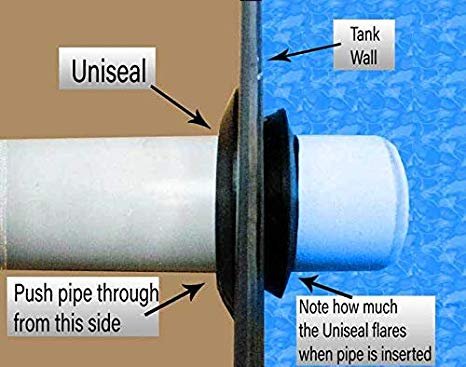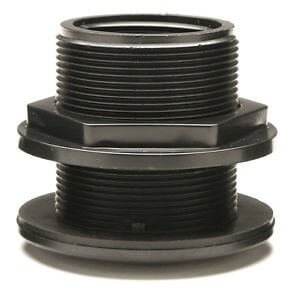Are you having trouble figuring out how to attach plumbing to your curved fish tank? If you’re thinking about using a standard bulkhead, let me warn you; it’s not going to work in this particular situation. This is because most bulkheads are too rigid to fill up the entire circumference of the curve. What you need here is a flexible rubber uniseal.
A uniseal will be available in most standard plumbing sizes (1-inch, 3-inches,…) and has a variety of uses. But before we get to a full-fledged comparison on the uniseal vs bulkhead, let’s see what they really are.
What Is a Uniseal Fitting?
A uniseal or a uni seal is a rubber seal that is used to run pipes through tank walls, water filters, and storage devices.

The fitting is inserted into a slightly larger hole of a wall or tank surface. For example, a two-inch rubber uniseal fitting will require a three-inch hole. The water carrying pipe is then lubricated with a soap solution and fitted inside the uniseal.
When the pipe is squeezed in through the outside of a uniseal, its inside walls contract to create a watertight compression. This makes uniseal a highly effective barrier against leakage. Uniseal fittings are ideally used for plumbing on curved surfaces and come in varying sizes.
What Is a Bulkhead Fitting?
A bulkhead is a hard seal that is used as a water inlet for pipes and faucets. Similar to how a uniseal operates, a bulkhead fitting allows you to drill a hole into a water reservoir. This lets the water flow to its destination, back to the fish tank.

Each bulkhead fitting comprises of a gasket, body and locking nut that seals it in place. The fitting is usually made of a plastic called polyvinyl chloride and can withstand temperatures up to 150 degrees Fahrenheit (65 degrees Celcius).
Uniseal vs Bulkhead
Now that we know the primary workings of both plumbing techniques, let’s get into the nitty-gritty stuff. Handling water leakages requires an understanding of the leaking surface and the seal being used. Here, we evaluate the pros and cons of using uniseal vs bulkhead for standard water leaks.
Surface Type
When it comes to round or curved surfaces, a rubber uniseal is the best option as it is relatively malleable and can fit tightly around a pipe. However, keep in mind that a uniseal will only create a watertight seal with a sturdy tube or solid pipe like PVC pipe sealing. It will most likely collapse when paired with a flexible tube.
Pressure Capacity
A bulkhead has twice the pressure capacity than a uniseal. While uniseals can withstand pressures up to 65 psi (4,4bar), that’s nothing compared to the 150-psi (10,3 bars) pressure capacity of standard bulkhead fittings. If you are using a standard aquaponics setup, a uniseal is enough.
Seal Width and Size
A uniseal can fit into holes that are approximately one inch bigger than its original size. Therefore, it works best with small holes that fall within the half-inch to three-inch range. This fitting is ideal for smaller diameter piping like aquaponics and hydroculture projects.
Meanwhile, a bulkhead is the better option for larger diameter piping.
Installation Process
A uniseal is simpler to install because all you need to do is push a pipe into it. Bulkhead fittings, which have layers of threads attached to gaskets are still easy to install.
Costs
A uniseal is significantly cheaper than a bulkhead. A two-inch uniseal is half the cost of a bulkhead that comes in the same size. Gaskets need to be purchased separately for larger bulkheads, which add to the cost.
Durability
Bulkheads are usually made of brass, plastic or PVC and are highly durable. They are much more resistant to heat and weather changes.
On the flip side, a rubber uniseal can disintegrate if it is exposed to sunlight for long periods of time. It is likely to crack under consistent heat and will collapse quicker than a PVC bulkhead. So make sure it’s shaded.

FAQ
How Big Does the Fitting for a Uniseal Need to Be?
A rule of thumb is to get a fitting that is about one inch bigger than the uniseal itself. The fitting for a standard two-inch uniseal needs to be 3 inches big.
Which Hole Saw Should Be Used for a 3” Uniseal?
You can use a metal drill bit hole saw depending on the surface you are cutting a hole into. For a 3-inch uniseal, remember to adjust your device to a 4-inch diameter so that the uniseal can fit into the hole properly.
Can a Uniseal Handle Heat?
No, most uniseals are not good conductors of heat and are likely to disintegrate faster on exposure. It’s advised to use uniseal fittings for pond plumbing only.
Where to Buy Uniseal Fittings?
If you’re looking to buy a rubber uniseal, head over to Amazon or your nearest DIY store. A standard three-inch tank adapter won’t cost you a lot.
Where to Buy Bulkhead Fittings?
A traditional three-inch PVC bulkhead from Amazon or your nearest DIY store will cost you much more than its uniseal counterpart. A higher price usually includes dual locking nuts and gaskets that go with the fitting.
Conclusion
So, who wins the uniseal vs bulkhead challenge? This depends on how you prioritize the pros and cons.
Generally, people use uniseals in aquaponics because they are easy to install, can handle the pressure and most importantly, they won’t cost you an arm and a leg.
 I have written a book that contains all the information you need to get started with aquaponics.
I have written a book that contains all the information you need to get started with aquaponics.
Don’t be the person that makes painful mistakes during your first aquaponics build!
It has 265 pages filled with information about aquaponics. It’s available in paperback or eBook format.
You can buy it here on Amazon.com

Nick loves building, managing and giving others advice on aquaponics. He created this website to do just that. He is the author of Aquaponics for beginners. If you got a question contact him here or read more on the about page here.
